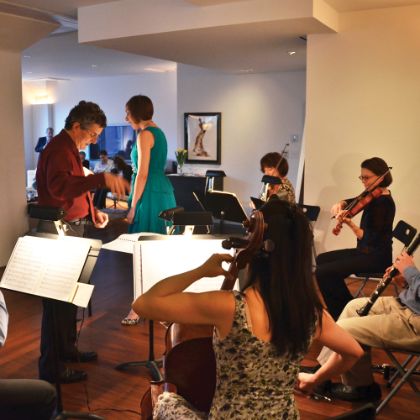The Cleveland Orchestra brings opera to Vienna’s Musikverein.
By Rebecca Schmid
Colored spotlights hung from the gilded ceiling. Topless, female sculptures looked down on twenty-six-foot projection screens. Animated foxes, birds and insects flitted across the stage. Last October, the conductor Franz Welser-Möst broke new ground in the Austrian capital. But he was not conducting the Vienna Philharmonic. It was the Cleveland Orchestra, celebrating its hundredth anniversary, that mounted the first staged opera in the history of the Musikverein.
Janáček’s The Cunning Little Vixen, as directed by Yuval Sharon, was an instant hit when first unveiled at Cleveland’s Severance Hall in 2014. By combining video animation with live action, the staging managed to exploit modern technology while returning to the roots of the opera: The libretto about a female fox who escapes from captivity, only to be killed by a greedy poacher, was originally inspired by a comic strip in a Czech newspaper.
With the guest production at Vienna’s iconic Musikverein, Welser-Möst intended above all to share the innovation which has made the Cleveland Orchestra popular at home with audiences of all ages. But he also hoped to give “fresh impetus” to the entire classical music world. “Our industry is not risk-friendly,” he admitted. “In a community like Cleveland, where the orchestra has such a high standing, we can take a risk and not lose our loyal followers. Some had never heard of Janáček, and then there were people who came for all four performances.”
Being progressive, however, does not necessarily mean following the latest fashion. “We are convinced that tradition — in the truest, most original sense — means moving forward,” the conductor said. Since taking the reins in 2002, he has revived an opera tradition cultivated by the institution in its early years. The Polish–born conductor Artur Rodziński in particular made an impact in the 1930s, leading such legendary performances as the American premiere of Shostakovich's Lady Macbeth of Minsk.
For Welser-Möst, who resigned from the Vienna State Opera four years ago over “irreconcilable differences” with the current administration, performing opera has been a way to nurture the Cleveland Orchestra’s flexibility but also explore creative avenues in programming. Janáček is a composer for whom he has a particular passion. As music director in Vienna, Welser-Möst conducted three new stagings of his operas, including Vixen. “It is still incomprehensible to me that this music is not played here more often given the proximity to Austrian culture,” he said. “It is also the job of interpreters to keep digging about what the piece says to us today and with what means we can tell the story.”
Both Welser-Möst and Sharon consider the Janáček production a holistic take on the opera in which the score comes into natural dialogue with both the animated sets and the hall in which it takes place. “The music is of course tantamount, but there is also this transformation that it goes through as soon as it’s realized in three dimensions,” said Sharon. “Some conductors have a harder time with that leap. For Franz, it’s part and parcel of the musical delivery.”
Perhaps more than any other director of his generation, Sharon is committed to expanding the formal possibilities of opera. In his home city of Los Angeles, the current MacArthur fellow included two dozen moving cars in his 2015 mobile opera Hopscotch and, most recently, decommissioned sirens from World War Two in War of the Worlds, a collaboration with the composer Annie Gosfield. But he is also in demand on Europe's most prestigious stages. This summer, he takes on Wagner’s Lohengrin at the Bayreuth Festival, becoming the first American to direct there.
Whether working at the Musikverein or on the streets of L.A., Sharon’s basic principles remain the same. In all his projects, he said, there is no “taking for granted what a certain building and expectation dictate. We can open up new directions even when things seem so stable and fixed.” With Vixen, Sharon believes that the production attained the “most important goal” of “realizing Janáček's piece exactly the way I think it needs to be realized. It happens to be that we're in the hallowed Musikverein. But there is the extra benefit of raising possibilities for what could happen in a space like this.”
Collaborating with an adventurous orchestral institution like Cleveland rather than an opera house can, paradoxically, presents creative advantages. “The opera world tends to be conservative in the way it thinks about the art and the audience,” the director admitted. “Here we're building everything from scratch. There is no storage where we just pull out a wall or a costume. Every person outside the orchestra had to be brought on individually, with a certain kind of teamwork in mind.”
The use of animation, created by Walter Robot Studios, provided Sharon with an alternative to dressing the singers in furry costumes and asking them to act like animals. Here, with the exception of the second love duet between the Vixen and the Fox, the animal characters’ faces appear in peepholes above animated bodies so that they are subsumed into a kind of running cartoon. In a particularly beautiful moment, when the Vixen dreams about being a woman in Act One, she transforms into a ballerina, dancing across the night sky.
“The piece has always been challenged by trying to realize the animal-and-nature aspect of it,” said Sharon. “It can come across as silly because the piece has deep, philosophical ideas. For me, the right way to present them was to actually highlight the separation between animals and humans — as a nod to the original [concept behind Janáček's libretto], but also as an opportunity to be less spatially bound to its realism.”
While the opera addresses many themes about love, death and life, Sharon believes that Vixen ultimately illustrates how humans cannot help abusing their natural surroundings. “We project our own ideas about what the animal kingdom must be like because we only understand our own relational behavior. That’s where a lot of the humor comes from: The Fox ask things like, ‘Do you smoke? Do you like eating rabbit?’ But that's also what is so melancholy about the piece. The harmony between humanity and nature is desired but not realized.”
In the final scene, the Forester appears to step into the animation. “It's as if he becomes part of a language which he's always been separated from,” said Sharon. “That boundary is like the world of our desires, a projected vision of a harmony that doesn't exist in the world. It’s a moment of realization for the Forester that the reality around him might not be all there is, that there is some sort of metaphysical dimension.”
If imagery such as the setting sun of this tableau can mesmerize the viewer, the presence of all musicians onstage is part of the production’s aesthetic. Sharon is averse to the term “semi-staging,” however. “The problem is that it's not satisfying as a piece of theater or as a concert. So in the end no one is happy. I think of it [Vixen] as a full staging with the orchestra present. There are moments where the screen is less impactful so that we keep our gaze on the orchestra. The constant life of the instrumental music stays part of the drama.”
The Cleveland Orchestra has a close relationship with the Musikverein, having toured there at least biennially since Welser-Möst became music director. Just two days after performing Mahler's Sixth Symphony in Paris, the musicians arrived for dress rehearsal and immediately eased into a lithe, chamber-like account of Janáček's score. "We are not a loud orchestra, which works to our advantage," said Welser-Möst with regard to the hall’s acoustics, which famously expose every detail. The two-second reverberation time is not ideal for sung works, however. “The challenge is to shorten articulation and speed up diminuendi so that we achieve the same transparency as at home.”
While the production was designed for Severance Hall, it transported more easily to the Musikverein, a shoebox-shaped hall, than a vineyard-style space such as the Elbphilharmonie in Hamburg, whose raked seating would have exposed the backsides of the projection screens. If the side panels had to be cut down in width by about half and certain visuals adapted, the approximately seventeen-hundred–seat Musikverein ultimately provided another degree of intimacy. “It's a whole other level of immersion when the sound is so close and envelops you," said Sharon.
The smaller space also demanded less spotlighting on the singers' faces. Meanwhile, the production team played with the interior by projecting colored lighting onto the organ above the stage. Projection and lighting designer Jason Thompson noted the warm environment created by the hall's golden finish. "Severance is all aluminum," he explained. "Both halls take color from light so well, so the lighting design is complimentary to the animation. We want the audience to feel like the video is emanating into the hall."
Both in Cleveland and in Vienna, the opening images on the projection screens recreated the respective interior of the hall until giant tree roots descended and a magical forest with circling dragonflies appeared. The animation is broken up into five hundred short videos which are synchronized with the score, allowing the production team to adapt to different tempi in the orchestra. Given the intimacy of the Musikverein, the animators also made small adjustments such as heightening the detail of the rainfall scene which follows the Vixen’s death in Act Three. After the opera had drawn to a close, a black-and-white caricature of Welser-Möst waved to the audience until the conductor appeared in person for the audience's long, standing applause.
The local press was also full of praise for the combination of vivid musicianship and imaginative sets. “Behind the formidable Cleveland Orchestra, nature sprung to life in the form of shimmering animation,” wrote Der Standard, citing “delicate effects” in the visuals “which harmonize well with the direction of Yuval Sharon — and pleasantly with the quality of [musical] interpretation.” The Wiener Zeitung maintained that the “creative sets and technically modern execution which have already been celebrated in the U.S. offer a dose of optical freshness for which many large opera houses could only wish.”
Bringing in the production nevertheless brought its share of technical challenges and extra expenses. The Musikverein, one of the world’s busiest presenters of touring orchestras, had to close its doors for two days to allow for rehearsals and bring in external contractors to take care of everything from make-up to supertitles. With the balconies occupied by the chorus and a double-stage extension taking up five rows, some two hundred seats could not be sold. The standing room at the back of the hall, beloved by music students and tourists, was also occupied by the animation and lighting team — all for only two performances.
“It was an exception,” said Musikverein executive and artistic director Thomas Angyan. He nevertheless noted that he “wouldn't exclude the possibility of such a production in the future” if a concept came along that, like Sharon’s, presented an original alternative to what takes place every night at an opera house and could be adapted to the space. “This could open a new chapter for opera performance in the concert hall.”

-

From Christemasse to Carole
The birth of Christmas in medieval England
Read More
By David Vernier -

The Next (Not-So-)Big Thing
New chamber orchestras are popping up all over America.
Read More
By Colin Eatock -

A Father's Lament
Finding solace in the sound of authentic sorrow
Read More
By Rev. Jake Bohstedt Morrill